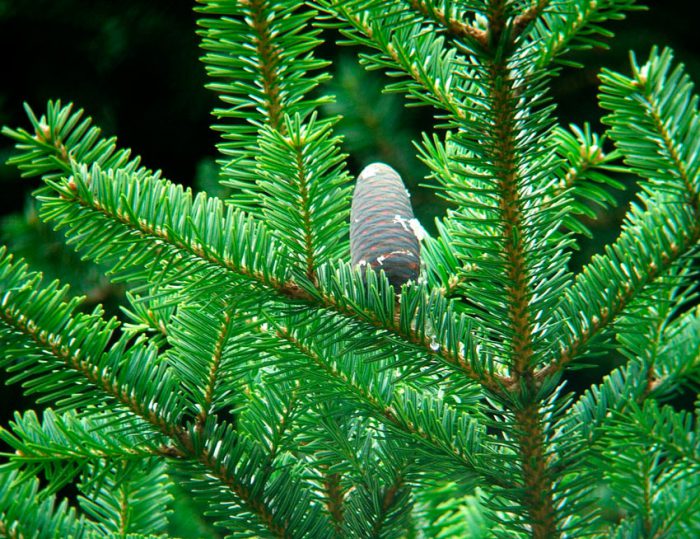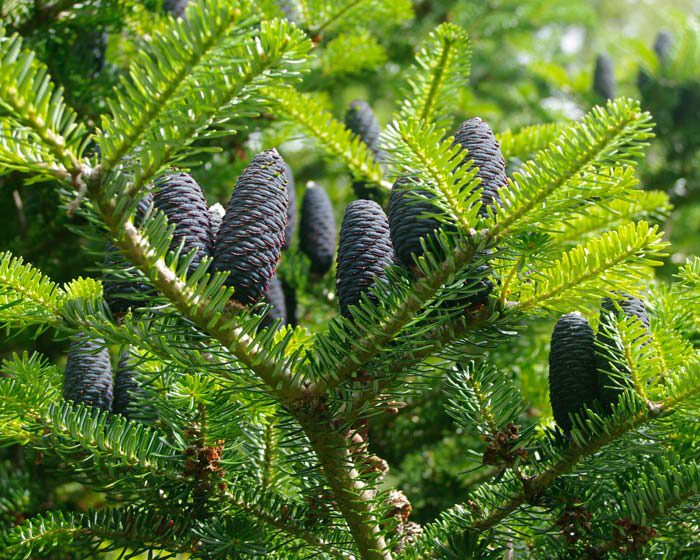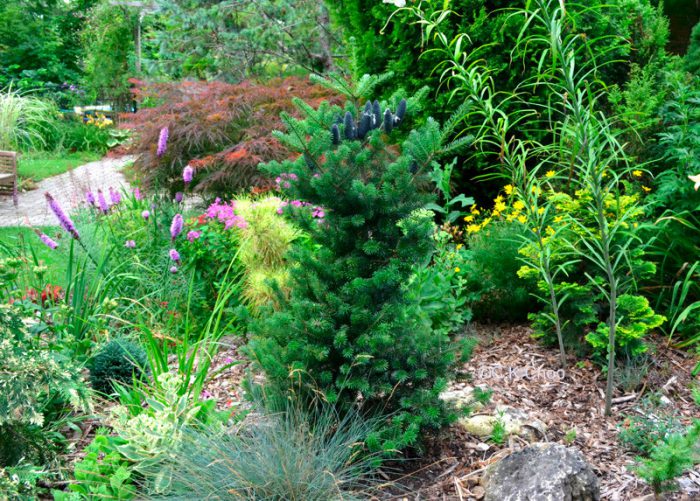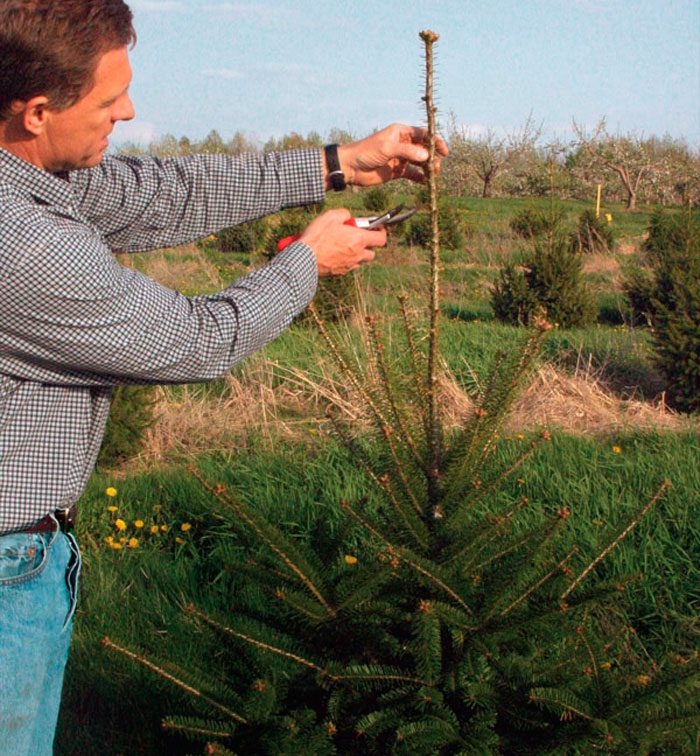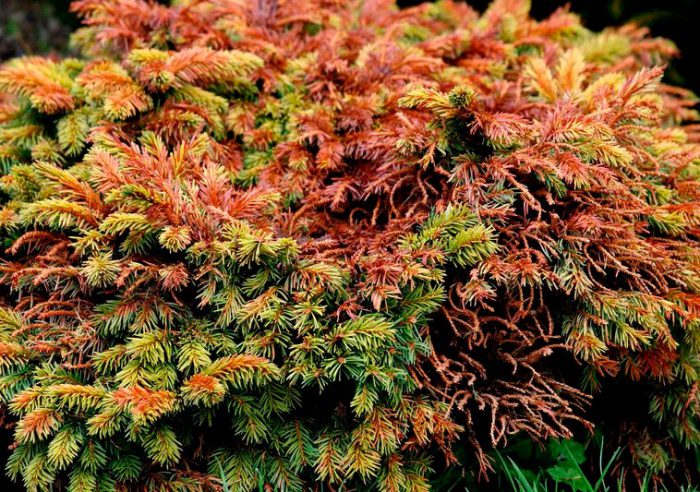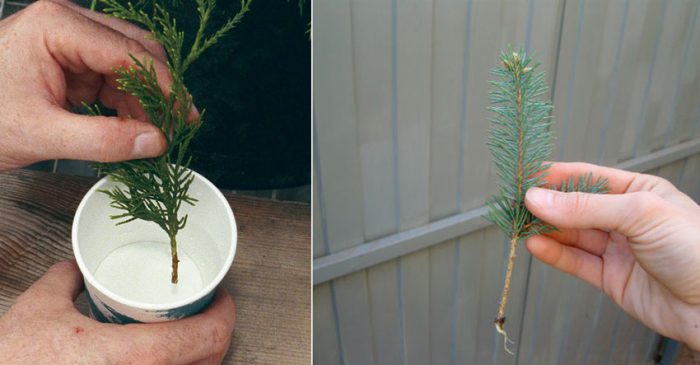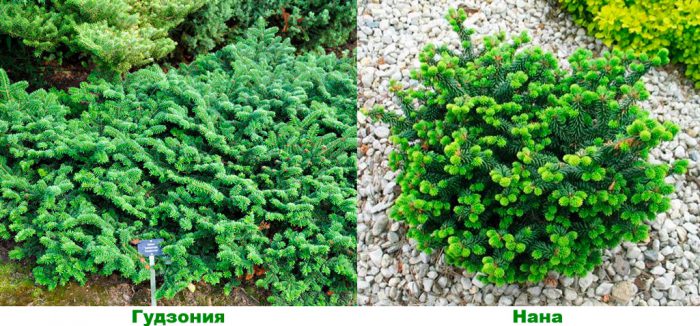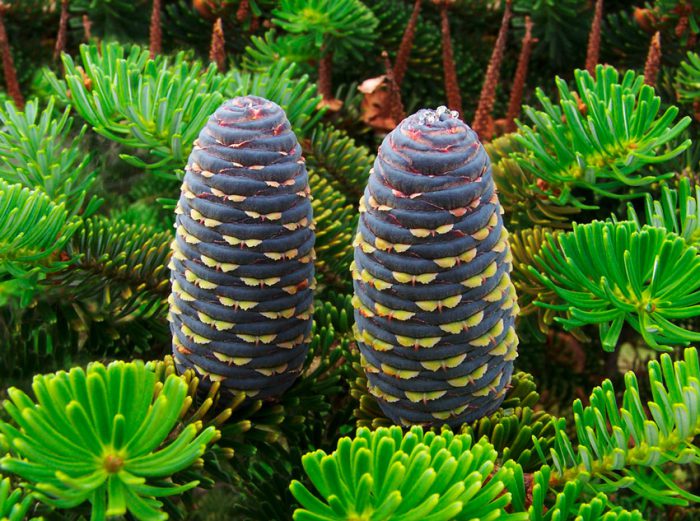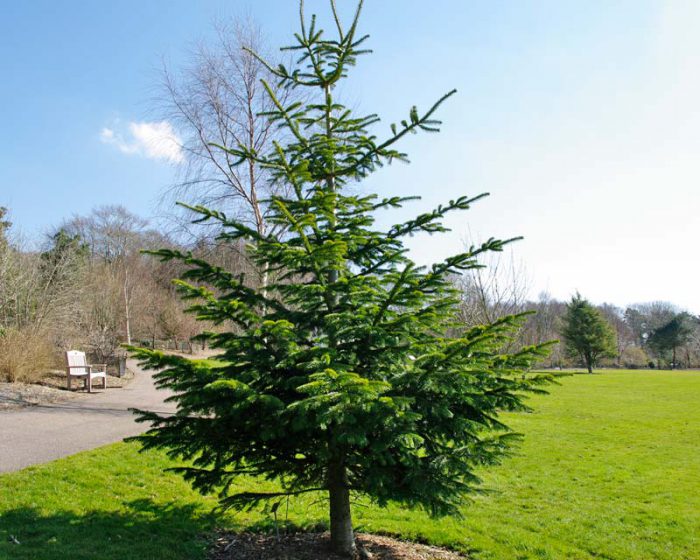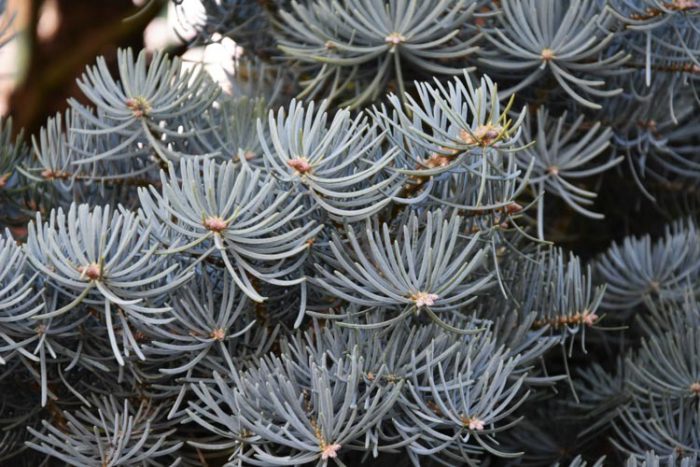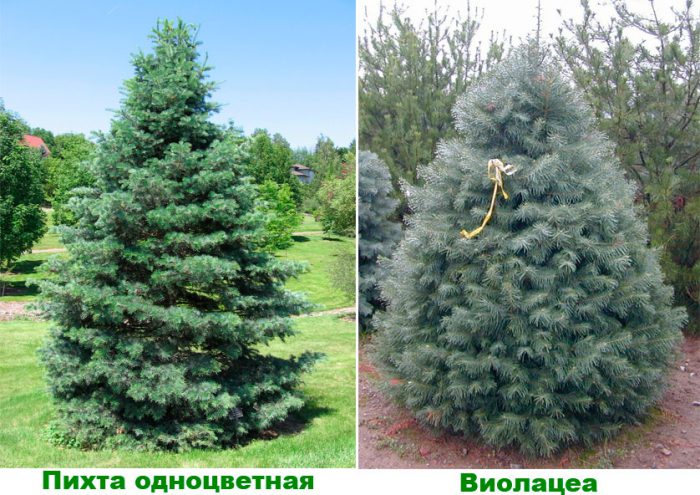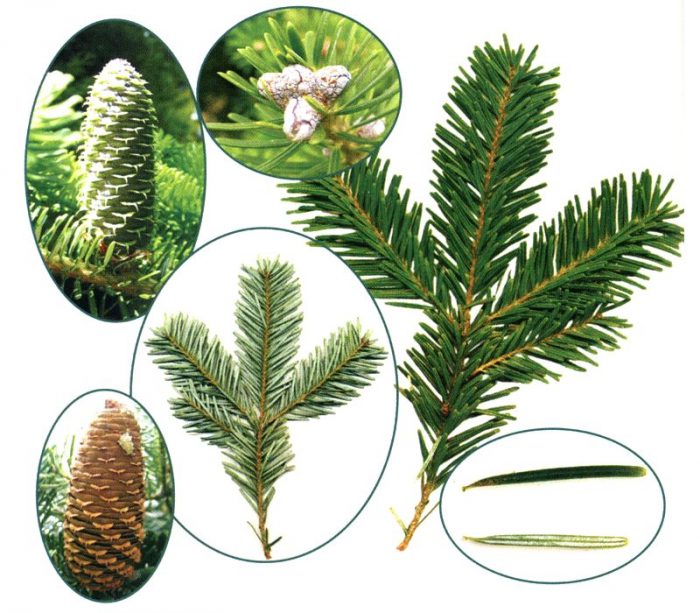The genus fir (Abies) belongs to the pine family. In Russia, the name of such a plant comes from the German word "Fichte", which means "spruce" in translation. In natural conditions, fir can be found in temperate, subtropical and tropical regions of the Northern Hemisphere, as well as in Mexico, Guatemala, El Salvador and Honduras. Often, fir prefers to grow in coniferous forests, while adjacent to pine, cedar or spruce. And such a tree can also be found in mixed and sometimes deciduous forests. This genus unites about 50 species of various plants, among which there are half-meter shrubs and trees, the height of which can reach 80 meters. At the moment, decorative fir is very popular, which is used to decorate squares and parks, as well as garden plots. Before you start planting fir, you should find out about its shortcomings, namely: low frost resistance, and also intolerance to gas, smoke and excessively dry air.
Content
Features of fir
Fir is an evergreen monoecious plant that loves warmth and is shade tolerant. A powerful rod system of roots goes into the deep layers of the soil. In a young tree, the bark is smooth and thin; over the years, it cracks and becomes thicker. The crown has a conical shape, and it begins directly from the base of the trunk, which distinguishes the fir from other conifers. The arrangement of the branches is annular-horizontal. The leaves are whole-edged flat non-rigid needles that taper at the base into a short petiole. In winter, the needles of most conifers turn dirty red, but not fir. On the lower surface of each needle there are 2 stripes of white color. The needles on the reproductive shoots are pointed, while on the vegetative branches they are slightly notched or have a rounded apex. The appearance of male flowers resembles cone earrings. Moreover, the female flowers have a cylindrical, ovoid or cylindrical-ovoid shape. Unlike other conifers, fir cones are directed upwards, rather than hanging down.The composition of female cones includes a rod with covering scales sitting on it, and inside them are fruit scales that carry a pair of ovules. Pollination of this plant is carried out by the wind. After the seeds ripen on the cones, the scales become stiff and fall off. In this case, the release of winged seeds occurs, and only the rods remain on the fir itself. Fir can be grown in the same place for 300 years.
Planting fir in open ground
What time to plant
Only those seedlings that are 4 years old or more are planted in open soil. Landing can be done in April, but it is better to do this in the last days of August or the first days of September. It is recommended to plant fir on a cloudy day. A suitable landing site should be in partial shade or shade. The soil should be fertile, moist, well-drained and better if it is loam. It is very good if a reservoir is located at a short distance from the landing site.
How to plant
The landing hole should be prepared half a month before the day of disembarkation. Its approximate dimensions are 60x60x60 centimeters, and the final value will directly depend on the dimensions of the seedling root system itself. Pour 20-30 liters of water into the prepared hole. After the liquid is all absorbed, the bottom of the hole must be dug up to half the bayonet of the shovel, and then a layer of broken brick or crushed stone is placed in it, the thickness of which should be from 5 to 6 centimeters. Then the hole is filled ½ part with an earth mixture consisting of clay, humus, peat and sand (2: 3: 1: 1), into which you need to pour from 200 to 300 grams of nitrophosphate and 10 kilograms of sawdust. After a couple of weeks, the soil in the hole will have to settle, after which you can proceed with the direct planting of the seedling. The root system of the plant is placed in such a way that its root collar is flush with the ground. It is best to set the root system on an earthen mound. After the roots are straightened, the pit will need to be filled with earth mixture (the composition is described above) and everything will be tamped well. The planted plant must be watered. In the event that you are planting a fir alley, then the distance between the seedlings should be from 4 to 5 meters. When planting in groups, the distance between plants should be from 3 to 3.5 meters for loose groups and 2.5 meters for dense groups.
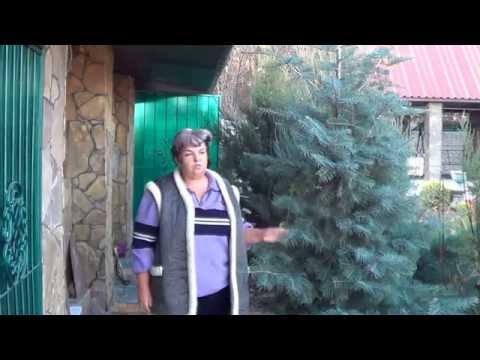

Watch this video on YouTube
Fir garden care
After each watering, it is required to loosen the soil no more than 10-12 centimeters deep, and it is imperative to remove the weeds. In young trees, it is recommended to sprinkle a trunk circle half a meter in diameter with mulch (sawdust, wood chips or peat). The mulch layer should vary from 5 to 8 centimeters. When doing this, make sure that the root collar of the plant is free of mulch. The planted fir will need to be fed only after 2-3 years, this should be done in the spring, by adding 100 to 125 grams of Kemira-wagon into the soil of the trunk circle. Only moisture-loving fir species require watering. For example, balsam fir needs to be watered 2 or 3 times during the whole season, but only during drought. For one watering, you need to pour 1.5–2 buckets under each tree. Other species do not need to be watered, as they react extremely negatively to waterlogging, and natural precipitation is enough for them.
Pruning
Pruning is carried out in the spring before sap flow begins, and all dry and injured branches must be removed. And at this time, you can, if necessary, start shaping the crown. Garden shears are used for pruning. It should be remembered that during one haircut, the stem can be shortened by no more than 1/3. As a rule, the crown of such a tree is very neat and does not require shaping.
Transfer
Conifers, when compared with other plants, tolerate transplantation quite well and quickly take root in a new place. In the event that a young plant is transplanted, then it is necessary to pierce the soil in a circle, stepping back from the trunk from 0.3 to 0.4 meters, using a sharp shovel for this. Then, with the same shovel, it is necessary to pry on the designated circle, immersing it in the soil to the depth of the bayonet. The fir is taken out together with a lump of earth and transported in a wheelbarrow to a new landing site, while it should be placed very carefully in the landing hole.
If the fir has already grown, then before proceeding with the transplant, it is prepared. To do this, the soil is pierced in a circle 12 months before the intended transplant, while more must be retreated from the trunk than in the first case. Within a year, the tree will grow young roots inside the designated circle, which will allow it to easily transfer the transplant. It should be noted right away that one person may not be able to cope with the transplant of the grown fir, so find an assistant in advance. It is very important not to allow the earthen lump to collapse during transplantation.
Pests and diseases
There is nothing difficult in planting and growing fir. This plant also has a fairly high resistance to diseases and harmful insects. However, sometimes it can begin to turn yellow, due to the fact that Hermes (a type of aphid) settle on it. To destroy such pests, use Antio or Rogor. At the beginning of spring, the female Hermes awakens, and it is at this time that the plant must be treated with a solution of any of these funds, while 20 grams of the drug is taken in a bucket of water. Also, these drugs will help get rid of pests such as pine cone leaf roll and fir shoot moth.
In some cases, this tree begins to turn yellowing of the needles, while rusty pillows appear on the stems. This indicates that the fir is infected with a fungal disease such as rust. Infected branches need to be cut off and destroyed, as well as the needles that fell off, then the cutting sites are processed using a garden pitch. The crown should also be processed and for this, a solution of Bordeaux liquid (2%) is used. Take a good look at the area where the fir grows, if there is a starfish or chickweed on it, then these plants must be dug up and destroyed.


Watch this video on YouTube
Fir propagation
If the fir is a species, then the generative method (seed) is used for its reproduction, while the harvesting of seeds is carried out as soon as the ripening of the cones begins. For the propagation of decorative fir, the grafting method is used.
Fir propagation by cuttings
The cuttings should be between 5 and 8 centimeters long. They should be cut only from young trees, while using only annual shoots, which have only one (not two!) Apical bud. Also, the stalk must be taken with a heel, for this it is recommended not to cut it off, but to tear it off with a sharp movement, while a piece of bark and wood of an older shoot should come off. Cuttings are harvested in the spring, choosing for this a cloudy morning. You need to take them from the middle part of the crown from its northern side.
Before planting the stalk for rooting, all burrs should be carefully removed from the heel. Also carefully examine the bark, it should not peel off from the wood. For preventive purposes from fungal diseases, it will be necessary to process the cuttings. To do this, they are immersed for 6 hours in a 2% solution of basezol or captan, and you can also use a dark pink solution of manganese potassium. After that, the cuttings are planted in an earth mixture, consisting of humus, sand and leafy earth (1: 1: 1). The planting is covered with a cap, which should be transparent.To speed up the rooting process, it is recommended to provide bottom heating of the soil, its temperature should exceed room temperature by 2-3 degrees. Move the cuttings to a well-lit place, protected from direct sunlight, and ventilate them every day. For the winter, the cuttings should be transferred to the basement, and in the spring they are taken out into the street. Rooting such cuttings is a relatively lengthy process. So, at the very beginning, an increase in callus occurs, and only in the second year roots are formed.
Growing fir from seeds
Collecting fir seeds is not easy. The fact is that in adult specimens, the ripening cones are relatively high, and the still ripe winged seeds fly away almost immediately. In order to extract the seeds, you need to pick a slightly unripe cone, which is dried and only after that the seeds are removed. Such seeds need stratification, for this, immediately after collection, they are placed in a basement with high humidity or on a refrigerator shelf. Sowing seeds in open soil in a prepared bed of turf and sand is carried out in April, while they need to be buried in the soil only a couple of centimeters. The crops are not watered, but immediately covered with a transparent film, in this case a crust does not form on the soil surface, and seedlings will appear much faster. The first seedlings should appear after 20-30 days. From this time on, it is necessary to start watering them, weeding and loosening the soil surface. In order for the seedlings to survive the first wintering, they should be covered with spruce branches. The next year, you can start transplanting young seedlings to a permanent place. The seedling obtained from the seed is at first characterized by extremely slow growth, because first there is a build-up of the root system. So, a four-year-old fir in height can reach only 0.3 to 0.4 meters. However, older plants grow much faster.
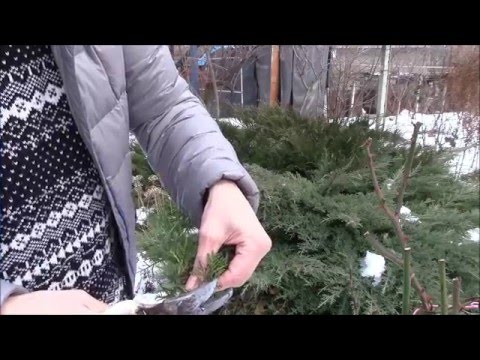

Watch this video on YouTube
Fir in winter
Preparing for winter
Those firs that experts advise to cultivate in the middle lane are distinguished by a fairly high frost resistance. But young specimens still need to be covered with spruce branches, while the surface of the trunk circle must be covered with a layer of mulch (dried foliage or peat), the thickness of which should be from 10 to 12 centimeters.
Wintering in the country
Adult firs are able to tolerate winter well without shelter. But in the last days of winter, it is recommended to protect them from the overly active spring sun; for this, the plants are covered with non-woven material.
Types and varieties of fir with photos and names
There are a fairly large number of species and varieties of fir, but not all of them are popular with gardeners. Below will be described those of them that are more or less in demand in culture.
Balsam fir (Abies balsamea)
Under natural conditions, such a fir can be found in the United States and Canada, while its habitat in the north is limited to the tundra. In mountainous areas such a tree can be seen growing at an altitude of 1.5–2 thousand meters. This frost-resistant shade-loving plant does not live very long, only about two hundred years. The height of such a plant can vary from 15 to 25 meters, and its trunk reaches 0.5–0.7 meters in thickness. Young fir trees are covered with gray-ash smooth bark. Older trees have cracked reddish brown bark. Resinous pale green buds are light purple in color and are spherical or ovoid. In length, dark green glossy needles can reach 1.5–3 centimeters, stomatal lines run along their entire surface. The needles can be slightly notched at the tops or blunt, they die off after 4–7 years. If you grind them, you can feel a pleasant aroma. The height of oval-cylindrical cones can vary from 5 to 10 centimeters, and their width is 2–2.5 centimeters.Unripe buds are dark purple in color, which after ripening changes to brown. Mature buds are highly resinous. This species has been cultivated since 1697. This fir is planted singly or used in small group plantings. The most popular forms are:
- Hudsonia... This mountain dwarf plant has very dense branches, a wide crown and many short stems. Short needles are wide and flat in shape, their front surface is green-black, and the back is bluish-green. Cultivated since 1810
- Nana... The height of the tree does not exceed half a meter, the diameter of the rounded crown is about 250 centimeters. Thick, spreading branches are arranged horizontally. The short, lush needles are colored dark green, while on its lower greenish-yellow surface there are 2 stripes of bluish-white color. It has been cultivated since 1850. This plant is perfect for landscaping roofs, terraces, and rocky gardens.
The following forms of this type are also cultivated: gray fir, variegated, dwarf, silvery, columnar, and even prostrate.
Korean fir (Abies koreana)
In nature, this kind can be found in the mountains of the southern part of the Korean Peninsula at an altitude of 1.8 thousand meters. These firs create clean forests and mixed ones. Young firs are very slow growing. However, in older specimens, the growth rate becomes faster over the years. In height, such a tree can reach 15 meters, while the trunk diameter varies from 0.5 to 0.8 meters. The shape of the crown is conical. Young specimens are covered with a smooth ash-colored bark, in some cases with a purple tint. Older specimens have chestnut bark with deep cracks. The practically round buds are only slightly resinous. Lush needles are tough enough. Each needle is saber-like curved and has a notch at its top. The upper surface of the needles has a dark green color, and the lower one is silvery (due to 2 very wide stomatal stripes). The length of the cylindrical cones is about 5-7 centimeters, and in diameter they can reach 3 centimeters. Young buds are colored lilac-purple. This plant was brought to European countries only in 1905. This species is distinguished by a very high decorative effect due to its two-color needles, as well as winter hardiness. This article describes the planting and care of this particular type of fir. Varieties:
- Blue Standard... It differs from the original species only in the dark purple color of the cones.
- Brevifolia... This cultivar is characterized by extremely slow growth and a dense rounded crown. The needles, in comparison with the original species, are not so dense, its upper surface is painted in a swamp-green color, and the lower one is grayish-white. The color of small cones is purple.
- Piccolo... A tree in height can reach only 0.3 m. In an adult specimen, the diameter of a spreading horizontal crown can reach up to 50 centimeters. The needles are the same as those of the main species.
Caucasian fir, or Nordmann fir (Abies nordmanniana)
This species is considered a Caucasian endemic, because in nature it can be found only in the Caucasus Mountains. In height, this plant can reach 60 meters, and the trunk has a thickness of about 200 centimeters. The low-set branchy lush crown has a narrow conical shape. The top of the crown is sharp, but in fairly mature specimens it is not very pronounced. The trees are covered with glossy smooth bark, but deep cracks form after the plant is 80 years old. Egg-shaped buds have practically no resin. The length of the needles is about 4 centimeters, and its width is about 0.25 centimeters, its upper surface is painted in dark green, and on the bottom there are 2 stripes of white color. On cone-bearing shoots, the tops of the needles are gently pointed, and on vegetative shoots, there is a notch at the tops.The cones reach 20 centimeters in length and 5 centimeters in diameter. Young buds are green and old buds are resinous dark brown. This species is fast-growing, and such a plant can live for about 500 years. Forms of Caucasian fir: weeping, golden-pointed, gray-gray, erect, golden and white-pointed.
White fir (Abies concolor)
Such a fir is considered the queen among the representatives of the genus of fir. Under natural conditions, it can be found in the Southwestern United States and northern Mexico. This tree prefers to grow in river canyons, as well as on mountain slopes at an altitude of 2 to 3 thousand meters above sea level. This species has a very high drought tolerance, and such a tree can live for about 350 years. Its height can vary from 40 to 60 meters, and the thickness of the trunk reaches 200 centimeters. The cone-shaped crown of a young tree is very lush, but as it ages, it thinns significantly. The color of the bark on older specimens is ash-gray, while it is very rough and cracked. The green-yellow resinous buds are spherical and about 50 mm in diameter. The length of the green-gray needles can be up to 7 centimeters, and its width is up to 0.3 centimeters. The apex of the needles is rounded and notched, while the stomatal lines are located on both their upper and lower surfaces. The shape of the cones is cylindrical-oval, they can be up to 14 centimeters long and 5 centimeters wide. The color of unripe cones is green or purple, and the color of mature cones is pale brown. It has been cultivated since 1831. This plant looks incredibly beautiful against the background of yellowed larches in autumn. Popular decorative forms:
- Fir Compact... A dwarf shrub cultivar with open branches and blue needles. In some cases it is referred to as the Glauck Compact.
- Violacea... The height of such a fast-growing plant can reach up to 8 meters. The wide crown has a conical shape, and the long needles are bluish-white. This fir is distinguished by a very high decorative effect and drought resistance.
Siberian fir (Abies sibirica)
Under natural conditions, it can be found in the north-east of Russia, while this tree prefers to grow in river valleys, as well as in the highlands. This species is notable for its winter hardiness and shade-loving nature, and it is under state protection. Siberian fir is the most famous species of all that are included in this genus. In height, the plant can reach no more than 30 meters, and its narrow crown has a conical shape. The gray bark is smooth almost along its entire length, but at the very bottom it cracks. Narrow glossy needles are very soft, and they reach 30 mm in length. Their upper surface is dark green, and on the lower one there are 2 stripes of white color. Ripe upright buds become pale brown. Siberian fir varieties: white, graceful, blue, variegated, etc.
Not only the species described above are cultivated, but also such firs as: subalpine, Frazera, whole-leaved, equally scaled, Semyonova, Sakhalin, mayra, graceful, cephallian or Greek, tall, Vicha, white-brown or bud-scaled, white or European and Arizona.
Fir properties
A plant such as fir stands out strongly from all others (even conifers). The fact is that the wood of this tree contains no resinous substances at all, and this allows it to be used to create musical instruments, as well as to build ships. Fir bark is used to prepare a very valuable balm, and fir oil is extracted from needles and branches. A decoction made from bark and needles can increase performance, strengthen the immune system, eliminate toothache, and lower acidity in the stomach.
The resin of this plant has a powerful antiseptic effect, so it is used to treat cuts, ulcers, wounds and abrasions.For a long time, the indigenous inhabitants of America, as well as the first settlers, treated various diseases with fir resin, for example: cough, cancer, otitis media, scurvy, bronchitis, tuberculosis, eliminated pain in the throat, dysentery, inflammation of the mucous membranes, vaginal infection, gonorrhea, rheumatism, and they also removed pain in joints and muscles.
Medicines containing fir cell juice extract are used for various inflammatory processes, acute and chronic heart failure, rheumatism and infectious diseases. Fir cell sap is capable of:
- improve hematopoiesis;
- strengthen immunity;
- fight inflammatory processes (used in the treatment of pulmonary diseases);
- prevent the development of hypertension;
- to normalize and significantly improve the work of the excretory organs;
- normalize the work of the digestive tract;
- saturate the body with missing macro- and microelements, as well as vitamins;
- protect from exposure to radiation;
- have a sedative and antioxidant effect, as well as increase the body's resistance to negative environmental influences.
It is also used in the prevention of heart and vascular diseases and oncology.
You can buy fir juice in the form of a phyto-cocktail, it is completely ready for use. You can also buy it in its natural form, but this type of juice can be drunk exclusively diluted.
Fir essential oil shows very good results even in cases in which various chemotherapeutic drugs are absolutely powerless. For example, this oil helps to slow down, and in some cases stop the growth of cancer cells. The oil goes directly into the bloodstream and accumulates in the focus of the disease, while it fully retains its healing properties, as it bypasses the digestive organs. The active ingredient in this substance is camphor. Fir oil is widely used in traditional medicine, as it has antibacterial, anti-inflammatory, sedative, bactericidal, analgesic, restorative and tonic effects. It is also quite popular in cosmetology, it is used to eliminate: lichen, edema, flabbiness of the epidermis, acne, boils, wrinkles, warts, etc.
Before you start using preparations or folk remedies prepared on the basis of fir, you should familiarize yourself with some rules:
- It is necessary for the duration of treatment to give up drinks that contain even a small dose of alcohol.
- You cannot take such funds if you have an individual intolerance to fir.
- These drugs can not be used for treatment for people with kidney pathology, as well as for patients with epilepsy, and with an ulcer or gastritis of the stomach. And they must be abandoned by pregnant and breastfeeding women, as well as children.
- If you use the product incorrectly or exceed the dosage, this can lead to an allergic reaction. If red spots appear on the skin, itching and swelling, the drug should be stopped immediately.
To check whether a product will cause an allergic reaction or not, you need to apply 10 to 15 drops of this drug to the skin on the back of your hand and rub it well. You can evaluate the result after 2-3 days. But even if you are not allergic to fir remedy, before taking it, you should consult with your doctor about the dosage before taking it.


Watch this video on YouTube

